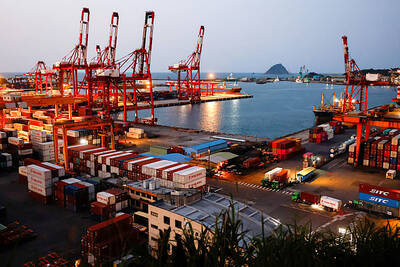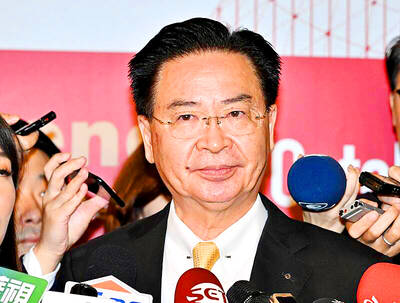Three years ago, Sharp Corp President Katsuhiko Machida challenged employees to phase out cathode-ray tube televisions in Japan by 2005.
The 58-year-old is right on schedule. Domestic sales of liquid-crystal display TVs surpassed those of their bulky predecessors for the first time in August. Global sales will probably triple to US$586 million in the year to March.
The switch reflects Machida's "Only-One" strategy of making products that are unique to Sharp. With demand for consumer electronics waning because of slowing economies and the US terrorist attacks, such innovation is the key to keeping Japan's biggest LCD maker out in front.
"The whole pie is shrinking," Machida said in an interview.
"Continuous effort to create demand by advancing technologies and applying them to new products is getting all the more important."
Investors like what they see. Sharp shares fell 8 percent this year, escaping a global technology slump. Rivals such as Sanyo Electric Co and Casio Computer Co dropped as much as 40 percent. The Topix Electric Appliances Index fell by a third.
"Sharp shines when the whole world is facing a tough situation," said Hideaki Mizuno, head of investments at ING Mutual Funds Management Co (Japan) Ltd, which handles about 6 billion yen (US$50 million) in Japanese equities. "I'm optimistic about the company's future, including its LCD business."
Osaka-based Sharp, which also makes flash-memory chips, said yesterday first-half net income fell 14 percent to ?16.3 billion because of lower prices for LCDs and other components. The company cut its full-year profit forecast 38 percent to ?26 billion.
Many rivals are posting losses.
Sony Corp, the No. 2 consumer-electronics maker, had a ?13.2 billion loss in the three months ended Sept. 30. Matsushita Electric Industrial Co, maker of Panasonic and Technics brands, had a ?50.1 billion loss and said worse is to come.
Sharp prides itself on unique products. Releases this year include the world's thinnest PCs, called Muramasa after a maker of razor-thin swords in ancient Japan, and air-conditioners using Sharp's technology to destroy mold and odor-causing molecules.
Sharp, which also makes the Zaurus series of handheld PCs and mobile phones equipped with miniature cameras, forecast in April that sales of consumer goods will generate 33 percent of operating profit this fiscal year, up from 29 percent last year.
By using Sharp-made LCDs and other parts in its consumer electronics, the company can avoid the component price declines that have befallen its rivals. Matsushita Electric posted an operating loss of 29.6 billion yen in the first half as sales of electronic components, mostly flat-panel displays and semiconductors for DVD players, declined 18 percent.
"LCD TVs are supporting utilization rates at Sharp's LCD production lines," said Masahiro Ono, an analyst at UBS Warburg (Japan) Ltd. "At the same time, the sales are contributing to overall consumer products revenue and earnings."
Sharp's strategy is not without pitfalls. Investors say that if the company were to stop innovating it would lose its advantage as rivals develop copy-cat products. In the market for thin-film transistor LCDs, screens commonly used in PCs, TVs and monitors, Sharp has already fallen behind South Korea's Samsung Electronics Co, according to DisplaySearch, a market researcher.
In the LCD TV market, where DisplaySearch estimates Sharp's share at about 86 percent, Matsushita, Korea's LG Electronics Inc.
and others have joined the race. Aiwa Co, an unprofitable Sony unit, is counting on LCD TV sales starting next year to help return to profit.
"The period when Sharp can have a lead over competitors is getting shorter," said Hideki Watanabe, an analyst at HSBC Securities (Japan) Ltd. "t's got to go back to the basics of how to maintain its competitiveness."
Machida inherited the spirit of invention from Sharp's founder, Tokuji Hayakawa. In 1912, the 19-year-old inventor of a belt buckle that required no fastening holes began his own metal works company. Three years later, he developed the "Ever-Sharp Pencil," the world's first mechanical pencil. The company was renamed after the device in 1970.
After moving to Osaka in 1924, a year after an earthquake and fire destroyed his factories in Tokyo, Hayakawa picked up where he left off. Sharp developed Japan's first radio in 1925, the nation's first television sets in 1951 and the first microwave ovens in 1961.
Then came Sharp's development of the world's first calculator in 1964, which led to the first practical use of LCD screens in 1973, prompted by Sharp's desire for a new screen to make the handheld devices smaller and thinner.
Sharp isn't taking the challenge from Korean, Taiwanese and domestic rivals lightly. The company has developed LCDs that save space and power by containing more chips than existing screens.
Sharp is developing a key part of the manufacturing process on its own for these new displays, called continuous grain silicon LCDs, to prevent rivals from copying them, Machida said.
To boost its stock, Sharp said in September it will buy back as many as 20 million shares, or 1.8 percent of the total, for ?27 billion.
Machida has taken innovation to employment too. Instead of expanding new hires, Sharp in the past three years helped 14,000 workers learn new skills so they can be shifted among the com-pany's divisions. As component demand slowed this year, it moved workers from LCD and chip plants to factories making mobile phones, LCD TVs and other products.

US President Donald Trump yesterday announced sweeping "reciprocal tariffs" on US trading partners, including a 32 percent tax on goods from Taiwan that is set to take effect on Wednesday. At a Rose Garden event, Trump declared a 10 percent baseline tax on imports from all countries, with the White House saying it would take effect on Saturday. Countries with larger trade surpluses with the US would face higher duties beginning on Wednesday, including Taiwan (32 percent), China (34 percent), Japan (24 percent), South Korea (25 percent), Vietnam (46 percent) and Thailand (36 percent). Canada and Mexico, the two largest US trading

China's military today said it began joint army, navy and rocket force exercises around Taiwan to "serve as a stern warning and powerful deterrent against Taiwanese independence," calling President William Lai (賴清德) a "parasite." The exercises come after Lai called Beijing a "foreign hostile force" last month. More than 10 Chinese military ships approached close to Taiwan's 24 nautical mile (44.4km) contiguous zone this morning and Taiwan sent its own warships to respond, two senior Taiwanese officials said. Taiwan has not yet detected any live fire by the Chinese military so far, one of the officials said. The drills took place after US Secretary

CHIP EXCEPTION: An official said that an exception for Taiwanese semiconductors would have a limited effect, as most are packaged in third nations before being sold The Executive Yuan yesterday decried US President Donald Trump’s 32 percent tariff on Taiwanese goods announced hours earlier as “unfair,” saying it would lodge a representation with Washington. The Cabinet in a statement described the pledged US tariffs, expected to take effect on Wednesday next week, as “deeply unreasonable” and “highly regrettable.” Cabinet spokeswoman Michelle Lee (李慧芝) said that the government would “lodge a solemn representation” with the US Trade Representative and continue negotiating with Washington to “ensure the interests of our nation and industries.” Trump at a news conference in Washington on Wednesday announced a 10 percent baseline tariff on most goods

‘SPECIAL CHANNEL’: Taipei’s most important tasks are to stabilize industries affected by Trump’s trade tariffs and keep negotiations with Washington open, a source said National Security Council Secretary-General Joseph Wu (吳釗燮) arrived in the US for talks with US President Donald Trump’s administration, a source familiar with the matter said on Friday. Wu was leading a delegation for a meeting known as the “special channel,” the Financial Times reported earlier. It marked Trump’s first use of the channel since returning to the White House on Jan. 20. Citing a source familiar with the matter, the Financial Times reported that Minister of Foreign Affairs Lin Chia-lung (林佳龍) was also a part of the delegation. The visit came days after China concluded war games around Taiwan and amid Trump’s